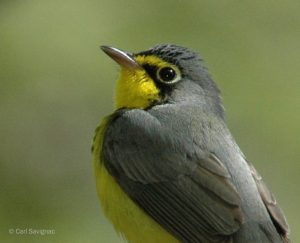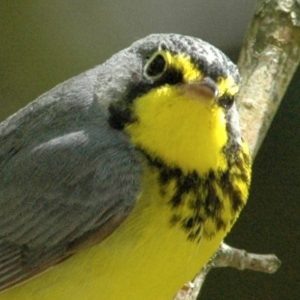Overwintering Canada Warblers in Colombia display migratory connectivity!

Sarantia Katsaras
A study published by the University of Saskatchewan, Topography of the Andes Mountains shapes the wintering distribution of a migratory bird, revealed that there is migratory connectivity between the breeding and wintering groups of Canada Warblers overwintering in Colombia. Knowing how the wintering grounds landscape determines the Canada Warbler distributions will help to determine conservation priories for the species.
The breeding origin of Canada Warblers overwintering in Colombia was determined by analyzing stable hydrogen isotope values in their feathers. Established stable hydrogen isotope values for North America indicate where feathers come from. Feathers are good indicators of geographic location because they form quickly and once formed are metabolically inactive. Migratory birds molt their feathers prior to migration in the spring and fall. The new feathers formed prior to migration, on the breeding grounds, contain distinct stable hydrogen isotope values from the region where they were grown. Therefore, when these feathers are analyzed on the wintering grounds (i.e. Colombia) scientists can determine where the individual’s breeding ground was.

Canada Warbler by Carl Savignac
The research concluded that the Andean mountain range in Colombia plays a role in the winter distribution of individuals from different breeding populations. Although during migration Canada Warblers from different breeding regions come together they separate again once on the wintering grounds. This was evident on the wintering grounds because individuals overwintering in certain areas had different probabilities of breeding ground origin. For example, the Canada Warblers overwintering in the Cauca basin are more likely to come from the northern and western regions of the breeding range, while the birds from the Piedmont basin are more likely to come from the south-eastern region of the breeding range.
An issue associated with Canada Warblers having strong migratory connectivity between breeding and wintering grounds is that they may not be able to adapt to environmental and land-use changes, such as deforestation and fragmentation. A high degree of connectivity between breeding and wintering grounds causes the different populations to be more vulnerable to change. The Western breeding populations are stable while the Eastern breeding populations are declining rapidly. This may be related to habitat loss and local environmental conditions in the Eastern Andes, which is where the Eastern breeding population is more likely to overwinter.
Knowing Canada Warbler migratory connectivity is important for the conservation of the species and its critical habitat. Targeted actions can be taken to help the populations most at risk. To learn about how Nature Canada is contributing to the conservation of this species at risk bird check out the Canada Warbler International Conservation Initiate page.



